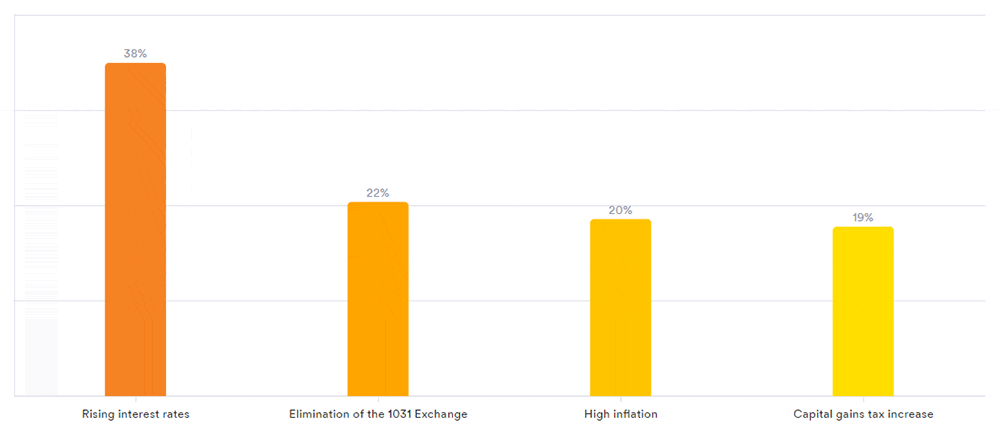The February LANDTHINK Pulse revealed 38% of respondents believe that rising interest rates would have the most negative impact on the land market. After about three decades of relatively low inflation, consumer prices are skyrocketing again. The Consumer Price Index rose by 7.9 percent through February, the fastest pace of annual inflation in 40 years.
February Pulse Sponsored by
The February report barely caught the start of the continued surge in gas prices that came in response to Russia’s invasion of Ukraine late last month. Economists expect inflation to pick up even more because prices at the pump have since jumped to record-breaking highs. The national average gas price in the U.S. is above $4 for the first time since 2008. On average, prices climbed about 7.5%, the fastest pace of inflation since 1982. The Fed chair has pledged to bring inflation under control. The Fed has signaled it plans to raise interest rates several times this year – perhaps as many as five – beginning this month.
Last month, the February Pulse asked: Which of the following would have the most negative impact on the land market?
Last Wednesday, the Federal Reserve announced that it is raising rates for the first time since 2018. The Fed raised the federal funds rate by 25 basis points moving it from 0% to a targeted range of 0.25% to 0.5%.
The federal funds rate, which is set by the central bank, is the interest rate at which banks borrow and lend to one another overnight. The federal rate is different than the rate that consumers pay, but the Fed’s moves still affect the borrowing and saving rates they see every day. When the Fed hikes interest rates, you’ll see rates on credit cards, mortgages, personal loans, student loans, car loans and more start to tick up as well. The cumulative effect of rate hikes impact the economy and household budgets.
As interest rates rise, they reduce affordability. Higher rates increase mortgage payments and reduce the amount of money people can borrow. As indicated by the results of last month’s Pulse, Americans are anticipating that their households could see their borrowing power weakened by continuously rising rates.
There is another way to look at this. The rural land market has been hot for over two years now, but with fierce competition and skyrocketing home prices, the deck was stacked against buyers. Land inventory evaporated, with the limited supply driving multiple offers above asking and many of them all–cash.
It sounds odd to hear, but higher interest rates could mean opportunity for buyers of rural land for sale. A rate spike would throw a glass of cold water on an accelerated land market, reducing demand and triggering a decline in land prices. As a result, land prices could moderate, resulting in a more balanced market.
Another reason why the land market may experience fewer negative affects of rising rates is because of an increase in cash purchases in the past two years. Paying cash gave buyers an edge against competitors in the strong seller’s market. The uneven economic impact of the pandemic allowed some buyers to save more money, investors to see substantial stock market gains and homeowners to receive top dollar for their properties. All of these factors contributed to an increase in cash buyers, which may continue through spring and summer.
So far in 2022, financial markets have taken a wild ride, with dramatic swings in both stocks and cryptocurrency values. Russia’s invasion of Ukraine sent stocks spiraling the next morning, upon news of new sanctions. For most, it was a reminder of the importance of portfolio diversification.
Historically, investors have leaned on land as a stable cornerstone of their portfolio. Higher-net-worth buyers flocking to property in tumultuous times is not a brand new phenomenon. Hard assets like timberland and farmland are a good hedge against both inflation and economic downturns. They can provide a continuous cash flow from leases and timber income, as well as tax benefits.

Coming in a close second, 22% said that elimination of the 1031 Exchange would have the most negative impact on the land market. The 1031 exchange has been a part of the tax code since 1921, and allows owners of a business or investment property to postpone paying capital gains taxes if they reinvest the proceeds from the property sale in a qualifying, like-kind exchange. The 1031 is a powerful economic tool, and the boost it brings to the economy clearly supports its 100-year-old existence.
Proponents of the section 1031 assert that its use in transactions makes for a more buoyant real estate market. Many investors utilize the 1031 exchange, since the deferral of the capital gain tax gives them significantly more purchasing power and encourages their continual exchange of assets, since they don’t take a big tax hit.
Many in the real estate industry, as well as those participating in the Pulse, feel that elimination of the 1031 exchange would make sellers reluctant to sell their properties. If the government eliminated the 1031 exchange, a domino effect could spur a downturn in the real estate market as well as a decrease overall economic activity.
For over a year the real estate industry has feared that the 1031 Tax Deferred Exchange could be on the chopping block under the Biden administration. When they took office, there was a lot of talk about doing away with the 1031 Exchange system in an effort to raise additional taxes. For now, it appears like-kind exchanges may have dodged a bullet. Whether or not the Biden administration and Congress decides to place a cap on them or eliminate them remains to be seen, but it’ll be closely watched but those in the land industry.
Last month’s survey results were all over the board, but the majority of respondents (38%) indicated that Rising Interest Rates would have the most negative impact on the land market. Coming in a close second, 22% said Elimination of the 1031 Exchange would have the most negative impact. This was followed by 20%, who said High Inflation and 19% said Capital Gains Tax Increase.
LANDTHINK would like to thank Mossy Oak Properties for sponsoring the February Pulse and for coming up with a very interesting question to pose to our audience. The Mossy Oak Properties network, which began franchising operations in 2002, now has over 100 franchised brokerages in 30 states throughout the country, with the network completing 4,900 transactions totaling $1.4 Billion+ in sales volume for 2021. Mossy Oak Properties knows rural land and real estate. They are America’s Land Specialist. Contact Mossy Oak Properties today to find your favorite place!
This content may not be used or reproduced in any manner whatsoever, in part or in whole, without written permission of LANDTHINK. Use of this content without permission is a violation of federal copyright law. The articles, posts, comments, opinions and information provided by LANDTHINK are for informational and research purposes only and DOES NOT substitute or coincide with the advice of an attorney, accountant, real estate broker or any other licensed real estate professional. LANDTHINK strongly advises visitors and readers to seek their own professional guidance and advice related to buying, investing in or selling real estate.











Add Comment